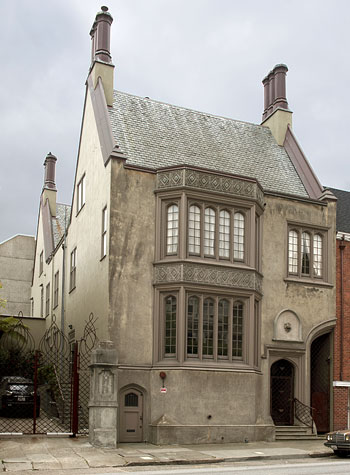San Francisco Landmarks
Tobin House
1969 California Street
Built 1915
Willis Polk designed the Tobin House. It is representative of his penchant for medieval English architecture and restrained use of decoration as panaceas for what he deemed the architectural chaos of San Francisco's late nineteenth-century streetscape.
In 1911, Michael H. de Young purchased two lots on the south side of California Street between Gough and Octavia Streets, directly adjacent to his own estate and gave the deeds to two of his daughters, Helen, wife of George E. Cameron, and Constance, wife of Joseph O. Tobin, an executive at Hibernia Bank and member of one of San Francisco's oldest and wealthiest families.
Michael de Young also offered to build homes on these lots for his daughters and their young families, but for years nothing happened. Both the Tobin and Cameron families chose instead to live in affluent towns south of San Francisco.
Michael de Young was the patriarch of one of the most powerful and influential families in San Francisco. He arrived in San Francisco from Baltimore with his mother and brother Charles during the Civil War. The brothers founded the Daily Dramatic Chronicle, which changed its name to the Daily Morning Chronicle, and soon established their dominance in the newspaper industry.
By the 1870s their paper was so influential and widely read that the de Youngs could make or break a politician, policy, business deal, or any other matter of importance in Northern California. Though de Young's editorial policies elicited as much ire as they did new subscribers, his paper had become the mouthpiece for the Republican Party by 1880.
In 1889 M. H. de Young reinforced his newspaper's power by commissioning the first steel-frame sky scraper on the West coast, a ten-story building designed by the Chicago firm of Burnham and Root, and located at the comer of Kearny and Market Streets. He had also accumulated enough wealth to build the family mansion in one of the most fashionable neighborhoods of 1880s San Francisco, at the crest of California Street in the Western Addition.
The Chicago World's Fair of 1893 inspired de Young to spearhead efforts to stage a similar fair in San Francisco's Golden Gate Park in 1894. Not coincidentally, the resultmg Midwinter Fair helped to raise the value of the tracts of land that de Young owned in the largely undeveloped sand dunes to the north and south of the park.
The fair also fueled de Young's passion for collecting all sorts of objects and artwork. In 1916, he built a museum in the middle of Golden Gate Park to house this collection, which can still be viewed at the De Young Museum.

The Tobin House is also National Register Listing #09000806.
